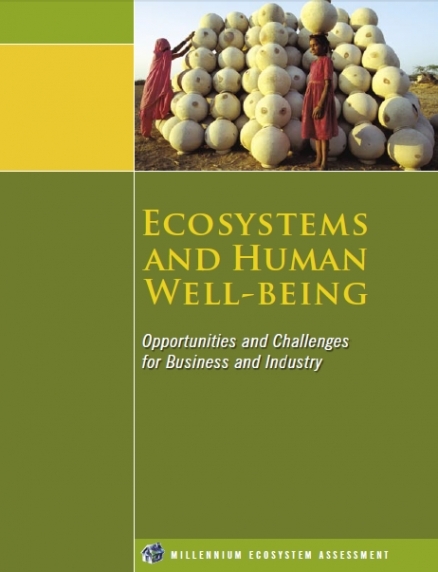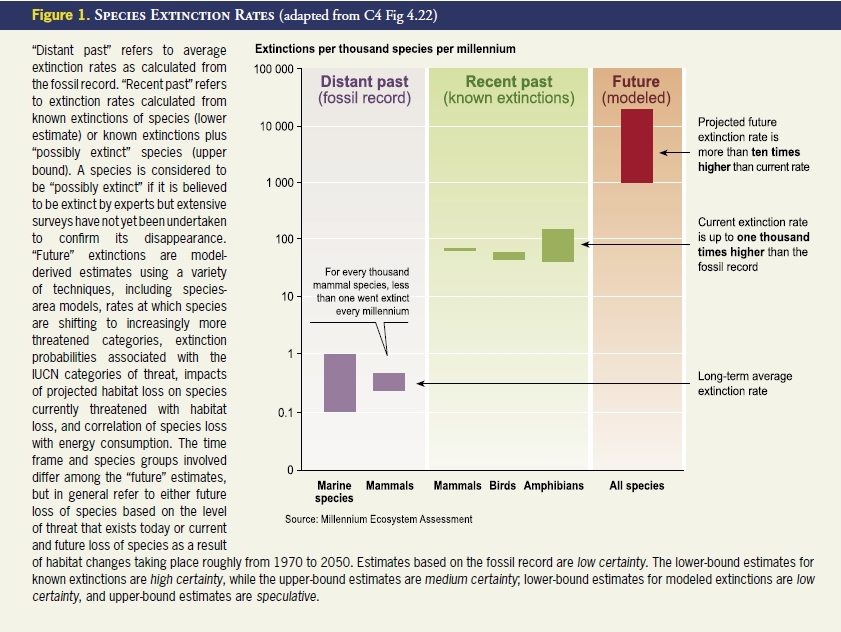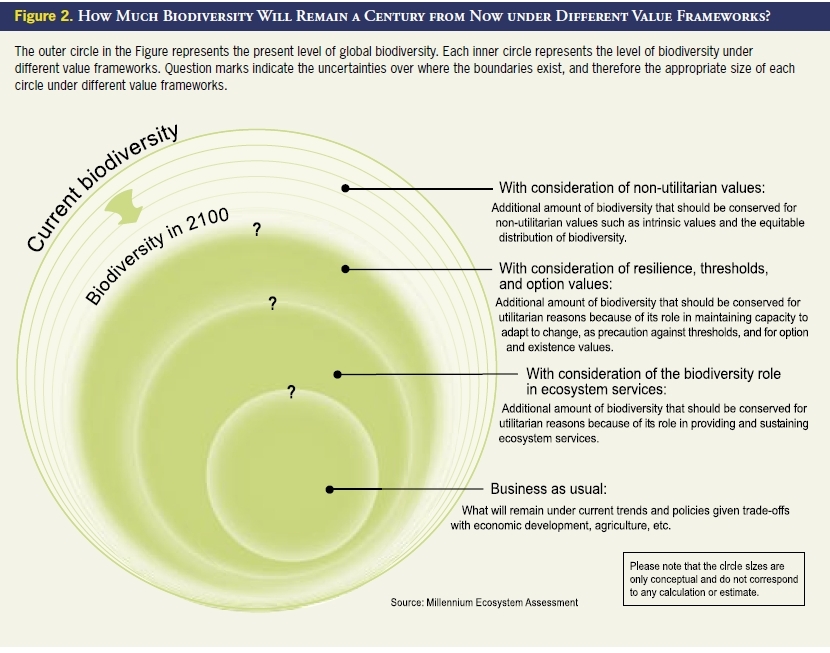Ecosystems and Human Well-being: Opportunities and Challenges for Business and Industry: The Bottom Line
This is part of the Millennium Ecosystem Assessment report Ecosystems and Human Well-being: Opportunities and Challenges for Business and Industry
People everywhere rely on ecosystems and the services they provide. So do businesses. Demand for these services is increasing. However, many of the world’s ecosystems are in serious decline, and the continuing supply of critical ecosystem services is now in jeopardy.
The loss or degradation of ecosystem services will have impacts on human well-being. It will also profoundly affect businesses. Higher operating costs or reduced operating flexibility should be expected due to diminished or degraded resources (such as fresh water) or increased regulation.
|
|
|
An ecosystem is a dynamic complex of plants, animals, microbes, and physical environmental features that interact with one another. Ecosystem services are the benefits that humans obtain from ecosystems, and they are produced by interactions within the ecosystem. Ecosystems like forests, grasslands, mangroves, and urban areas provide different services to society. These include provisioning, regulating, and cultural services that directly affect people. They also include supporting services needed to maintain all other services. Some ecosystem services are local (provision of pollinators), others are regional (flood control or water purification), and still others are global (climate regulation). (See Figure 1.) Ecosystem services affect human well-being and all its components, including basic material needs such as food and shelter, individual health, security, good social relations, and freedom of choice and action. (See Figure 2.) |
Every threat creates opportunity. Innovation and technology to minimize the damage to ecosystems and to mitigate impacts already occurring are creating significant new business opportunities for those who are aware and prepared.
The impacts of ecosystem degradation will be felt over both the short term—the next 5 years—and the longer term—the next 50 years. But many businesses will experience an array of direct and indirect impacts immediately because ecosystem degradation is changing public policy, consumer preferences, supplier relationships, stockholder expectations, and competitor strategies, all of which vary by country and region of the world. Many governments, NGOs, and leading companies are already taking action.
Regardless of its focus, a business will be more competitive if it bases decisions about strategic direction, product offerings, production, transportation, and marketing on the best available information about the current and projected condition of ecosystems and ecosystem services. The MA provides a framework for understanding ecosystem services and provides scientifically credible information about the important linkages between those services and human well-being.
As demands for the services provided by ecosystems grow and the ability of these systems to meet these demands is eroded, increasingly difficult challenges must be confronted. For example:
- How do we meet the growing demand for food (projected to increase by 70–80% in 50 years) without further harming the environment or the integrity of the food supply chain?
- Given the unevenly distributed supply of fresh water, how do we meet agricultural, industrial, and consumptive needs around the world?
- Given the expected increase in demands for energy, what are the most efficient and effective strategies to produce energy while also minimizing impacts to air quality and climate?
- How do we balance conservation of biodiversity with opportunities for economic development associated with alteration or conversion of habitats?
- How do we balance increasing demand for seafood and expanding opportunities for aquaculture, while promoting the health of fresh and coastal waters and restoring depleted wild fisheries (Fisheries and aquaculture)?
Business is positioned to be a very positive force in addressing these challenges through pursuit of new business opportunities and markets, reduction of operational footprints, development and deployment of new technology, and establishment of effective partnerships. In addition, businesses can demonstrate leadership in support for and reform of public policy that seeks to raise industry environmental performance standards in order to gain first-mover advantages while improving the reputation of their industry as a whole with important customers and constituencies.
It is in business’s self-interest to take a leadership role in reducing poverty, improving human well-being, and protecting the environment. Doing so will help secure stable and safe societies, preserve open and free markets, ensure access to critical resources, provide new product and business opportunities, avoid abrupt social and environmental changes, and, for the most astute and agile, carve out competitive advantage.
The MA outlines actions businesses can take that would improve their bottom line, reduce degradation of ecosystems, and benefit human well-being. These actions include:
- Identify and understand the ecosystem services that a business uses or affects (including those important to suppliers, partners, customers, and other constituencies) and adjust corporate strategies accordingly.
- Manage in an integrated way the interacting and multiple demands on ecosystem services throughout supply chains and product life-cycles.
- Increase efficiency of ecosystem-service use or ecosystem-service supply by developing, deploying, or marketing new technologies that improve operations, reduce impacts on ecosystems, and meet increasing demand for ecosystem services.
- Pursue partnerships with other companies, government agencies, and civil society organizations to help accelerate corporate learning about ecosystems and ecosystem services, leverage resources and skills, and build trust with important stakeholders.
- Take business decisions that anticipate growing customer preferences for sustainably supplied services, new regulations, competitor strategies, investor demands for sustainable business models, and the establishment of market mechanisms. For example:
- reduce carbon emissions,
- decrease nitrogen and phosphorus loading,
- increase efficiency of water and energy use,
- protect natural habitat and biodiversity,
- achieve the sustainable management of natural resources, and
- make decisions informed by the full “life-cycle” costs of products.
- Provide objective information on the impact of operations on ecosystem services to key stakeholders (including the public) to build trust, help create a value-adding reputation, and help strengthen the business case for ecosystem conservation.
|
The MA provides a comprehensive analysis of ecosystem status and trends, options for action, and scenarios that explore the trade-offs to be confronted. |
There are four components of the MA analysis:
? condition and trends in ecosystems and services associated with human well-being;
? scenarios of contrasting possible futures with respect to changes in ecosystem services;
? possible responses by governments, nongovernmental organizations, and businesses to ecosystem changes; and
? sub-global assessments that analyze the nested local, national, and regional scales at which ecosystems and human well-being are connected.
An overarching synthesis, MA Board Statement, and four additional reports that integrate MA findings concerning biodiversity, desertification, wetlands, and human health are also available.
Terms of Use
The copyright for material on this page is the property of the World Resources Institute. Click here for the Terms of Use (Ecosystems and Human Well-being: Opportunities and Challenges for Business and Industry: The Bottom Line).
Disclaimer: This chapter is taken wholly from, or contains information that was originally written for the Millennium Ecosystem Assessment as published by the World Resources Institute. The content has not been modified by the Encyclopedia of Earth.
|
|


